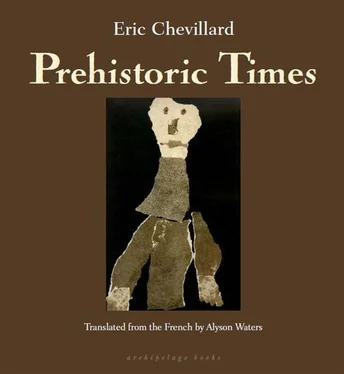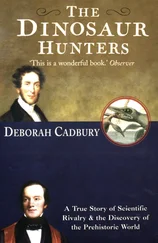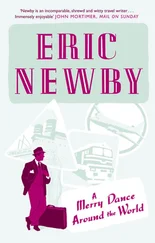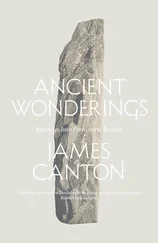But among all these indefinable figures there is one whose strangeness is due neither to the poor quality nor bad condition of the painting; on the contrary, it is certainly among the most perfect and best preserved in the cave. I have the reproduction in front of me: at first, it looks like an izard head and so you ask yourself: What’s the problem? Only the izard has such curved horns. But then you can make out two thinner lines extending from the horns and branching out to form what are in fact the powerful antlers of a megaceros; so the problem is solved, it was a paltry enigma, and then the eye discerns in the tangle of antlers the very clear shape of a roaring feline and everything becomes arranged differently; one mistook the thick stream of urine with which the wildcat marks its territory for an antler and now that this interpretation has become obvious, you can no longer even find the outlines of the izard or the megaceros; this hypothetical ruminant’s profile in fact calls to mind an eagle’s spread wing, and indeed I can clearly recognize the hooked beak of the raptor; how could we have seen in it the head of a roaring feline? It’s an eagle in flight, no point in looking any further, the curved line of its back no more resembles a stream of urine than it does a mammoth’s trunk, for example. We have to admit it looks too much like a mammoth’s trunk not to be one, and then the whole pachyderm immediately appears in three-quarters profile — we mistook its frightening right tusk for a bird of prey’s wing — so strange is this figure that when observed more closely it could be taken for a salmon, a crab, or a bison, judging by the woolly fur of its turtleneck. Our indecision is partly due to a whole slew of pentimenti, the traces of which are vaguely visible, often just barely. But, by and large, what do we really know about the aesthetic ideas of troglodyte painters? Why should we deny them the possibility of imagination and reduce their inventive audacity to an ignorance of the laws of perspective obeyed in realist animal art? To reproduce is to admit, and thus it is to submit, to agree to follow the herds of reindeer and their coprophagous flies in all their migrations. But man’s relation to the world changes the moment his imagination comes into play, it changes completely; it’s no longer a relation of constant humiliation and subjection, quite the opposite: it reverses completely, takes a turn for the better, and henceforth quadrupeds will have four equidistant left feet, they won’t go far. And so it was done.
As for the anthropomorphic figures in the cave, other than the headless woman and the penguin, they are few and far between, somewhat sloppy, and reduced to a bare minimum: all it takes are two eyes, two dark rings painted on a natural protuberance of the cave wall. This single portrait is used for every face, the resemblance is there, startling, a mirror could not do better, anyone can recognize himself in it; that dazed look is definitely our own — the malice of the gaze and the irony of the smile cannot change a thing about it, our face is one big nose that expresses, more than anything, a lack of comprehension. Perhaps this is why — and in order to feel as though they are part of the world in spite of it all, so as to merge with the other creatures and to be accepted by them, to fit in unobtrusively, without scandal, stealthily in other words — the other human characters who appear are all wearing animal masks, beaks and horns or plumage, and this clumsy ruse that communicates their goodwill by and large betrays their helplessness. The calm self-assurance of the animals accentuated the humans’ bewilderment all the more, emphasized their weakness and the erroneousness of their instincts that misled them about the taste of fruit and the chill of nights; so they made an attempt to escape this miserable, inferior, shameful condition by decking themselves out in feathers, skins, furs torn from animals who, once flayed, lose their arrogance, pink as the day they were born, equally tender, totally raw, and vaguely obscene because we replaced their silky fleeces with our own provocative nudity. Moreover, this exchange foretold the slow transubstantiation that would subsequently begin, following the domestication of the wild pig. And this explains why we devour so enthusiastically all the parts of its body, flesh of our flesh, from the snout to the tail, the dream incarnate of the anthropophagous butcher, the self-made man, nothing but obesity, foot shrunk to the nail, brains unraveling, fatty animal of tenderized human meat, without nerves, without soul, without that sickly sweet — but subtle, choice — aftertaste of sludge.
The V of “Vulva,” repeated over and again on the cave walls, already illustrates the dominant obsession of times to come. Two deep gashes made with flints — a crotch — the invisible body fills the surrounding space and is rendered almost palpable thanks to the power of suggestion of both the drawing and desire. More than thirty vulvae were counted on the single wall here, some large some small, some narrow some wide, spread out like a flight of gulls; but back then two different pictorial signs represented birds and vulvae, and we will have to wait until the advent of watercolors to see this superfluous distinction abolished at last. Another strange thing in the cave — this one unique and consequently less significant — nonetheless deserves a glance. I want to show you. If I can find it. Where was it? Don’t move. Wait here, I’ll be right back. If the catalogue is properly done, conceived from start to finish with the same logical rigor, this strange thing should be on the next page. Indeed it is. Here it is. We can get going. Next page. Stay behind me in a group. We’re turning.
STOP. Here we are. Don’t get under each other’s feet. Form a circle around me so everyone can see. You are now admiring the sole male sex organ in the cave, represented by a stalagmitic projection of forty centimeters (but it must have increased in size since the time the engraver traced the puny prone figure around it). Thick, opaline — not bad — it looks more like a block of frozen sperm. Who knows, perhaps it has conserved all its seminal virtues, but is it up to us to try our hand at artificial insemination? How far can science go, where do its rights end, who are we to fool around with the very principle of life, etc.? We know, moreover, that women did not do the work of decorating the caves, they were kept away from art just as they were from hunting, they were employed for the seasonal gathering of blackberries, plums, hazelnuts, the harvesting of edible roots, the collecting of eggs, snails, honey — I’m the bear, I go first, any objections? Such harvests in the wild were indispensable because agriculture did not yet exist, and that’s something we must repeat and retain: art preceded agriculture by some twenty thousand years, so that the old collective dream of fleeing civilization to renew our ties with primitive values and with the first passions of human beings does not entail, as one could be led to believe, buying a little ramshackle farmhouse and its fallow land, the practice of painting would be more pertinent — any monochrome painting is more rustic, typical, and authentic than a row of potatoes.
Motherhood was also exclusively left to women, which is no longer the case; quite the opposite in fact: today we may well be witnessing a transfer of responsibilities in this domain for, even if, as in the past, the mother still carries the child in her womb for the first months, afterward it is the father who lugs it around for ten years on his shoulders, where the larva goes through its slow metamorphosis by gaining weight on a daily basis. Kept down for too long by their education and then, until recently, by an unfair division of domestic labor, with access only to the wastewater from watercolors, women will finally be able to exercise their unsuspected talents freely. Imminent upheavals in the arts and sciences are to be expected; as soon as the legacy of this long bondage disappears, women will make their original voices heard and then it will be one surprise after another. One need only think of Pierre and Marie Curie. By mixing their radium with phosphorescent zinc sulfide, a person might perhaps lose some fingers, but one would also obtain a confection of glow-in-the-dark paint, opening whole nights to the possibilities of art. We would be at the dawn of history.
Читать дальше












